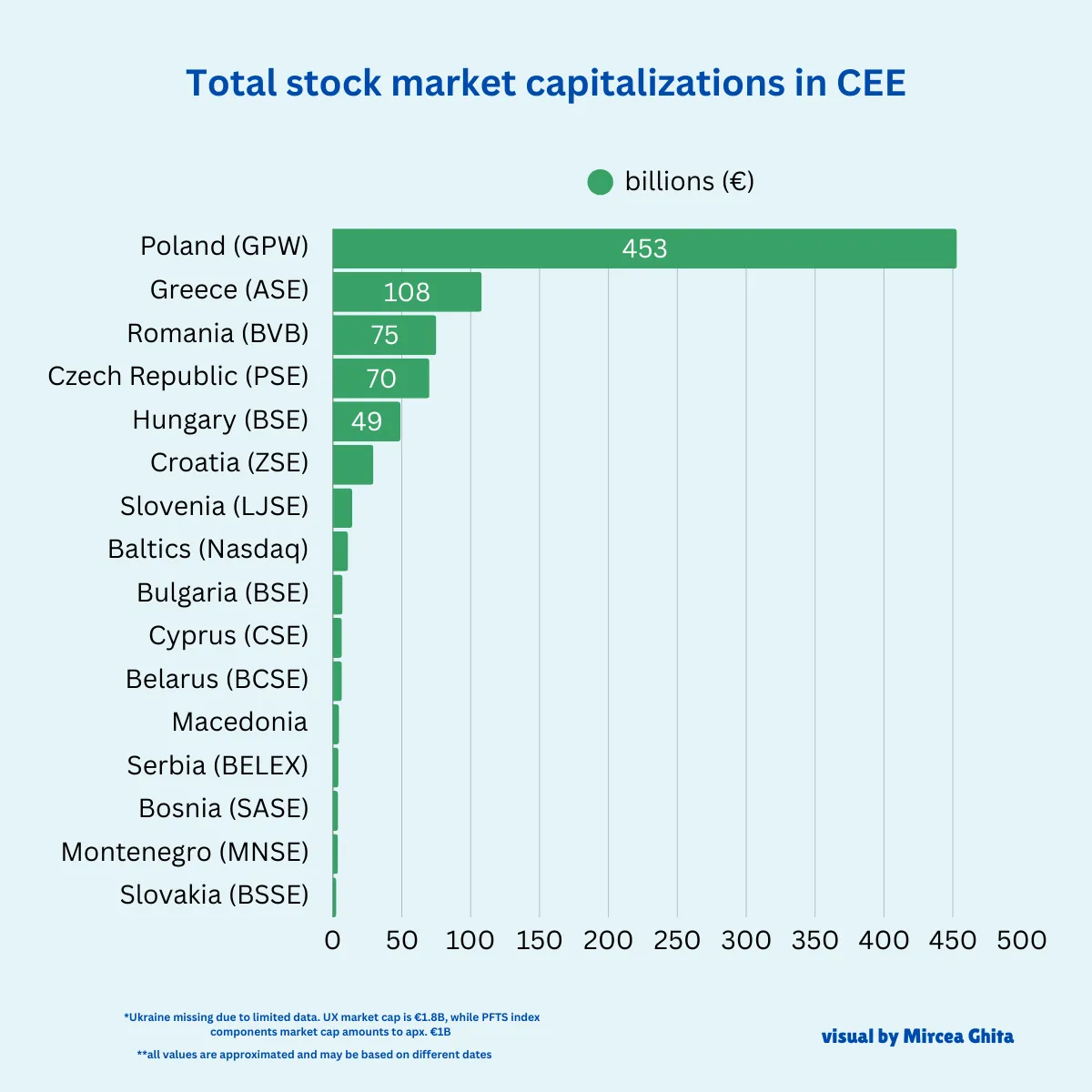The other day, I found myself thinking about: If there were no option to list your company outside of CEE, where would you list it?
It’s clear that companies with global ambitions disregard the region’s stock exchanges altogether, heading to places like New York, London, or Frankfurt. But I decided to dig into the numbers to understand the regional dynamics. I think the stock market of a country is a variable that shows the investment landscape maturity of a country.
So here’s the data:

Warsaw: the undisputed leader
By far, the standout in the region is the Warsaw Stock Exchange (WSE). With the largest market capitalization in CEE, Warsaw also has a few IT companies listed. 23 out of about 400 to be more specific. What sets Warsaw apart is not just its size but its ability to attract companies from outside Poland itself. The WSE has established itself as a regional hub, offering international visibility and liquidity that other exchanges in the region simply cannot match.
It’s not surprising, then, that companies from countries like Ukraine, the Baltics, and even the Czech Republic have chosen Warsaw as their listing venue. This cross-border appeal cements its status as the go-to market for those aiming to break beyond their local ecosystems.
The surprise of Athens
What did surprise me, however, was the scale of the Athens Stock Exchange. It ranks second in market cap among CEE stock exchanges - an impressive feat for a market I hadn’t considered to be so significant. While Athens primarily serves Greek companies, its size demonstrates that even in markets with challenges, there’s substantial activity and a notable level of investor interest.
Bucharest: local but growing
Coming in third is Bucharest, which primarily caters to Romanian companies. Unlike Warsaw, the Bucharest Stock Exchange hasn’t yet positioned itself as a hub for the broader region. Most of its listings are domestic, and while it’s growing, its reach remains relatively constrained due to the traditional type of companies being listed (with local operations). Interestingly, the largest European IPO in 2023 (Hidroelectrica) was in Bucharest.
Observations
One thing that stands out across these markets is the type of companies they host. The vast majority of listings in Warsaw, Athens, and Bucharest come from traditional industries - banks, utilities, energy companies, and manufacturing firms dominate the rosters. While there are pockets of innovation, these markets are still waiting for their breakout tech champions to make waves.
Also, if we cross the pond to Istanbul (which typically falls outside the region commonly referred to as CEE, but still Southeast Europe), we find another sizeable stock market. With about €320B market cap, it’s right after Warsaw.
And yet, even when you add up the market capitalizations of all the stock exchanges in CEE (total of apx. €1.17T), the sum still falls short of the market cap of a single global tech giant like Meta. It’s a humbling comparison that underscores how far the region’s markets need to go to compete on a global scale.
Related News
-
Merve Zabcı: Interview with Ekonomist Magazine
Merve Zabci, recently spoke with Economist about 2023 plans. At Logo Ventures, we focus on creating sustainable value creation and supporting our portfolio companies as they transition from start up to scale up.
-
Metis Ventures Enters CEE and Appoints Romanian Principal
Metis Ventures, an early-stage venture capital firm backing game-changing entrepreneurs tackling critical problems, has entered the Central and Eastern Europe (CEE) market. The team behind Metis Ventures has been investing in tech companies for over a decade, deploying $2B in public and private markets in total.
-
Founders Night: Techone VC & twozero Ventures
TechOne Venture Capital and Twozero Ventures brought together the founders of the startups in their funds at an event called Founders Night, held at Hamam Arts Hub.


